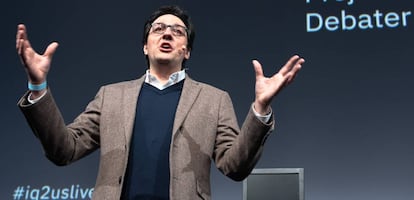Meet the Spanish engineer behind the world’s first quantum computer
Darío Gil is the new director of IBM Research, which recently unveiled the first commercial device using this promising technology


In the early 1990s, Darío Gil spent his last high school year at Los Altos High near Palo Alto, California. He never returned to Spain.
Gil went on to get a PhD in electrical engineering and nanostructures at the Massachusetts Institute of Technology (MIT). After graduating in 2003 he joined IBM and now, at the age of 43, he has been appointed director of the company’s vast research division, IBM Research, where he has 3,000 scientists working for him in 21 locations.
We need to take the best and give them the resources they need
Darío Gil, IBM Research
Gil has also been in charge of IBM Research’s Artificial Intelligence and Quantum Computing division since 2017, and last month the company presented its Q System One, the first commercial quantum computer, at an event in Las Vegas.
Quantum computing is one of IBM’s biggest bets for the future. “There is a risk, but from the theoretical point of view we have an extremely solid foundation,” says Gil in his first interview after becoming director of IBM Research. The interview took place at the company’s Think 2019 conference in San Francisco.
Quantum computing
A quantum computer is a feat of engineering. Its core is one of the coldest places in the universe. The outside environment is kept at 2.73 degrees Kelvin, while the inside of a quantum computer only functions without error at 0.01 degrees Kelvin, which is equivalent to -273 degrees Celsius.
This cutting-edge technology is now accessible through the cloud, and more than 100,000 people have already conducted millions of experiments to familiarize themselves with the way it works. The only catch is, it still can’t do anything that a regular personal computer doesn’t already do.

So when will a quantum computer do something that no supercomputer can perform today? Probably sometime in the coming decade. At IMB, they call that moment “the quantum advantage.”
In order to comprehend the scope of quantum computing, Gil uses the following comparison: decades ago, nuclear weapons got tested in remote archipelagos in the Pacific Ocean. But those tests ended when computers were developed that could recreate the results without an actual explosion.
The idea of developing materials computationally has been a dream ever since computers were invented
Darío Gil, IBM Research
A quantum computer will do something similar but on a different order of magnitude. Until now, the creation of new materials has been a trial-and-error affair, from the Bronze Age to our days. A quantum computer will be able to make better calculations and model materials in a way that is still unthinkable today.
“Right now, if there are 50 electrons in the molecule that you want to design, the number of calculations you need to perform with a conventional computer is in the order of 2 to the 50th power. Now imagine your molecule has more than 100 electrons (caffeine has more than 70). That’s impossible. You need to use all the atoms on the planet,” says Gil.
But not in the quantum world. “The idea of developing materials computationally has been a dream ever since computers were invented,” he notes. This could lead to batteries that last forever or perfect fertilizers, all developed by a computer rather than inside a lab. And materials are just one of the practical applications of quantum computing.
Research in Spain
Gil was born in Murcia, in southeastern Spain, but he grew up in Madrid, where his three siblings live. They, too, spent a year in the US as students, but they returned to Spain where they now work as lawyers and entrepreneurs. Darío was the only member of the family to go into the field of engineering, and the only one to remain in the US, where he married a woman from Portland (Maine).
Gil believes that his professional career would not have been possible in Spain where “we don’t have a research culture. I would really like it if having top-level research capability was not viewed as an accessory item in Spain. The difference is that if you ask [IBM CEO] Ginny Rometty about the importance of IBM Research, she will tell you that it is fundamental, permanent. And if you ask the State of Massachusetts about the importance of research, they will say the same. And same at the Pentagon or the federal government.”

There are several reasons why this US respect for research is not evident in Spain, adds Gil.
“We have benefited as consumers of research that has been carried out in other countries, but it is not part of the DNA of our own institutions,” he adds. “Research is almost done as charity here. We have so many talented people in Spain. It’s a wealthy, modern country that can afford it.”
“It is a cultural challenge and a leadership challenge. We need elite institutions that are not copies of previous existing institutions. We need to take the best and give them the resources they need. When you go someplace where things work well, and then you come back to Spain, you’re told that ‘you can’t do it that way because it violates these seven rules that we’ve got.’ Or you also hear that ‘we’re not going to pay scientists more than we’re going to pay executives.’ Well, why not?”
English version by Susana Urra.
Tu suscripción se está usando en otro dispositivo
¿Quieres añadir otro usuario a tu suscripción?
Si continúas leyendo en este dispositivo, no se podrá leer en el otro.
FlechaTu suscripción se está usando en otro dispositivo y solo puedes acceder a EL PAÍS desde un dispositivo a la vez.
Si quieres compartir tu cuenta, cambia tu suscripción a la modalidad Premium, así podrás añadir otro usuario. Cada uno accederá con su propia cuenta de email, lo que os permitirá personalizar vuestra experiencia en EL PAÍS.
¿Tienes una suscripción de empresa? Accede aquí para contratar más cuentas.
En el caso de no saber quién está usando tu cuenta, te recomendamos cambiar tu contraseña aquí.
Si decides continuar compartiendo tu cuenta, este mensaje se mostrará en tu dispositivo y en el de la otra persona que está usando tu cuenta de forma indefinida, afectando a tu experiencia de lectura. Puedes consultar aquí los términos y condiciones de la suscripción digital.
More information
Archived In
Últimas noticias
From Andorra to Gibraltar, a black market for Ozempic exploits its success: ‘They’re the most sought-after products in the world’
Magnets in their heads: How some animals guide themselves using the Earth’s magnetic field
From Hungary’s Orbán to Chile’s Kast: How Trump helps turbo charge the far right
The brief rise and retreat of Generation Z in Mexico
Most viewed
- Why we lost the habit of sleeping in two segments and how that changed our sense of time
- Trump’s obsession with putting his name on everything is unprecedented in the United States
- Charles Dubouloz, mountaineering star, retires at 36 with a farewell tour inspired by Walter Bonatti
- Venezuela faces its most tense Christmas yet
- The Florida Keys tourist paradise is besieged by immigration agents: ‘We’ve never seen anything like this’










































